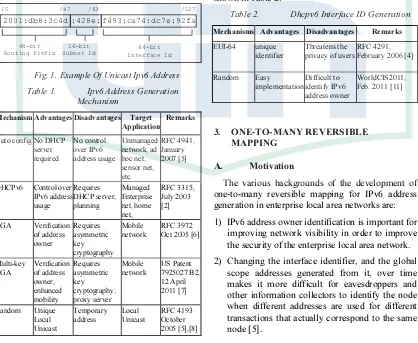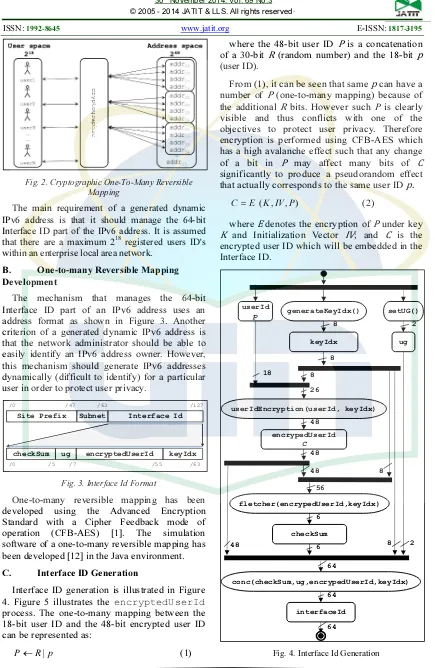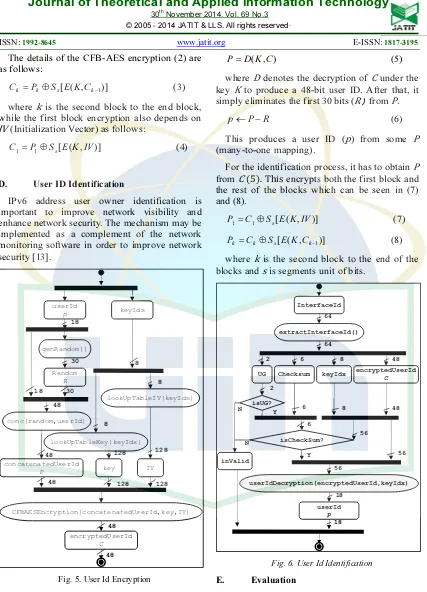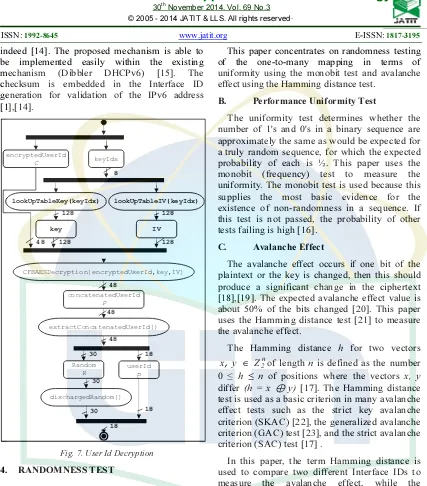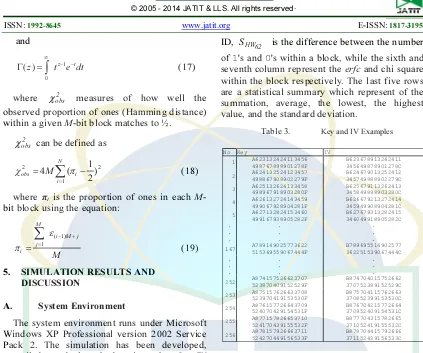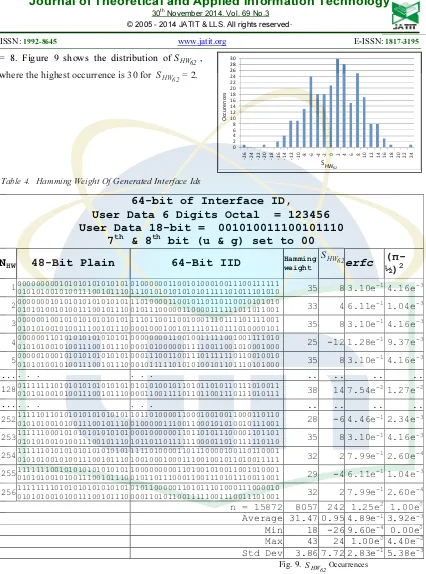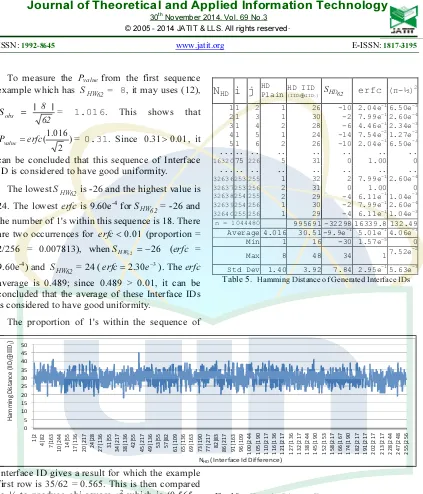571
RANDOMNESS TEST OF CRYPTOGRAPHIC
ONE-TO-MANY REVERSIBLE MAPPING FOR IPV6 ADDRESS
GENERATION
1NASHRUL HAKIEM, 2MOHAMMAD UMAR SIDDIQI, 3SIGIT PUSPITO W. JAROT, AND
4AKHMAD UNGGUL PRIANTORO
1
Department of Informatics, Faculty of Science and Technology, UIN Syarif Hidayatullah Jakarta 1, 2
Department of Electrical and Computer Engineering, Faculty of Engineering, IIUM 3
Indonesia Telecommunication Regulatory Body, Ministry of Communication and Informatics Republic of Indonesia.
4
Surya University, Indonesia
E-mail: [email protected], [email protected], [email protected], [email protected]
ABSTRACT
This paper presents simulation results on randomness test of a cryptographic one-to-many reversible mapping between user space and the IPv6 address space. A one-to-many reversible mapping mechanism is developed which may be embedded into a DHCPv6 (Dynamic Host Configuration Protocol for IPv6) server in the stateful mode within an enterprise local area network (LAN). Each time a user accesses the network, the DHCPv6 server is able to assign a dynamic IPv6 address. The dynamic address (obtained through one-to-many mapping) is to protect the user from unwanted behavior analysis exploiting IPv6 addresses, thus protecting user privacy. However, the dynamic address can be uniquely linked to the user (through many-to-one reversible mapping) if the need arises. The randomness of the dynamic address (one-to-many mapping) for IPv6 address assignment is evaluated based on uniformity using monobit (frequency) test, and avalanche effect is evaluated using Hamming distance tests. Simulation results show that the randomness in terms of uniformity (occurrence of 1's or 0's are around 50%) and the Hamming distance (the difference between Interface IDs at approximately 50%) are accepted. The decision rule of randomness is set at the 1% significance level with the Pvalue of monobit (frequency) test, and the Pvalue in Hamming distance tests is taken to be more than 0.01. IPv6 addresses generated by a one-to-many reversible mapping mechanism are considered to be random with a confidence level of 99%.
Keywords: Ipv6 Address, Randomness, Uniformity, Avalanche Effect, Monobit, Hamming Distance, P-Value.
1. INTRODUCTION
The one-to-many reversible mapping mechanism [1] is developed which can be embedded into the DHCPv6 (Dynamic Host Configuration Protocol for IPv6) servers in the stateful mode [2],[3]. The aim of this mechanism is to improve IPv6 addresses generation in terms of privacy and security via DHCPv6 in an enterprise local area network (LAN).
Each time a user accesses the network, a dynamic IPv6 address is assigned via a DHCPv6 server in the stateful mode. The dynamic address (one-to-many mapping) is to protect a user from unwanted behavior analysis exploiting IPv6 addresses, thus protecting user privacy. However, the dynamic address can be uniquely linked to the user (many-to
-one mapping) if the need arises to improve network visibility, thus protecting network security.
The requirement of a one-to-many reversible mapping for IPv6 address generation is that it should manage the 64-bit Interface ID part of an IPv6 address. It is assumed that the mechanism has to be able to manage up to 218 registered user IDs within an enterprise local area network.
The first criterion of one-to-many reversible mapping is that the processing speed for generating and identifying an address must be practical. Secondly, the collision probability of the Interface ID part of an IPv6 address must be very small. The proposed mechanism should integrate well with the existing mechanism (DHCPv6). Eventually, the mechanism should be able to perform validation for generating and identifying IPv6 addresses.
572 randomness test based on uniformity using the monobit test and avalanche effect using the Hamming distance test. These tests are to measure the randomness of the Interface ID for a particular user in order to protect user privacy.
The remaining of this paper is organized as follows. Section II describes works related to this research and Section III briefly reviews one-to-many reversible mapping. Section IV describes the method of the randomness test while Section V gives the simulation results and a discussion on these findings. Section VI provides the conclusion of this paper.
2. RELATED WORKS
A.
IPv6Address
IPv6 has 128 bits to specify the address of a node which is represented in hexadecimal format with colon notation [4]. An example of a unicast IPv6 address is shown in Figure 1. The first 48 bits are allocated for the network address and the following 16 bits are allocated for a subnet prefix within the network. The remaining 64 bits are allocated for the Interface ID.
Fig. 1.Example Of Unicast Ipv6 Address
Table 1. Ipv6 Address Generation
Mechanism
MechanismAdvantagesDisadvantages Target Application
Remarks
Auto config No DHCP server required
No control over IPv6 address usage
Unmanaged
CGA Verification of address
Random Unique Local
B. IPv6Address Generation Mechanism
IPv6 supports different mechanisms for assigning IP addresses to nodes as shown in Table 1.There are a number of researches concerning IPv6 address generation with advantages and disadvantages as well as the objectives of their applications. One of them is Dual Addressing Scheme (DAS) over IEEE 802.15.4 Wireless Sensor Networks [9], however it has different target application with the one-to-many reversible mapping in this paper.
C. Stateful Address Generation
Using SLAAC (stateless address autoconfiguration) eases the burden of administration of the network. However it is vulnerable [10]. Therefore a managed network using DHCP in the stateful mode is one the solution to address this problem [11]. This paper concerns to manage Interface ID's of unicast IPv6 addresses in the stateful mode (using DHCPv6).DHCPv6 has default mechanisms to assign IPv6 address to the node as shown in Table 2.
Table 2. Dhcpv6 Interface ID Generation
Mechanisms Advantages Disadvantages Remarks
EUI-64 unique identifier
Threatens the privacy of users
RFC 4291, February 2006 [4]
Random Easy
3. ONE-TO-MANY REVERSIBLE
MAPPING
A. Motivation
The various backgrounds of the development of one-to-many reversible mapping for IPv6 address generation in enterprise local area networks are:
1) IPv6 address owner identification is important for improving network visibility in order to improve the security of the enterprise local area network.
573
Fig. 2.Cryptographic One-To-Many Reversible
Mapping
The main requirement of a generated dynamic IPv6 address is that it should manage the 64-bit Interface ID part of the IPv6 address. It is assumed that there are a maximum 218 registered users ID's within an enterprise local area network.
B. One-to-many Reversible Mapping
Development
The mechanism that manages the 64-bit Interface ID part of an IPv6 address uses an address format as shown in Figure 3. Another criterion of a generated dynamic IPv6 address is that the network administrator should be able to easily identify an IPv6 address owner. However, this mechanism should generate IPv6 addresses dynamically (difficult to identify) for a particular user in order to protect user privacy.
Fig. 3.Interface Id Format
One-to-many reversible mapping has been developed using the Advanced Encryption Standard with a Cipher Feedback mode of operation (CFB-AES) [1]. The simulation software of a one-to-many reversible mapping has been developed [12] in the Java environment.
C. Interface ID Generation
Interface ID generation is illustrated in Figure 4. Figure 5 illustrates the encryptedUserId
process. The one-to-many mapping between the 18-bit user ID and the 48-bit encrypted user ID can be represented as:
p R
P← | (1)
where the 48-bit user ID P is a concatenation of a 30-bit R (random number) and the 18-bit p (user ID).
From (1), it can be seen that same p can have a number of P (one-to-many mapping) because of the additional R bits. However such P is clearly visible and thus conflicts with one of the objectives to protect user privacy. Therefore encryption is performed using CFB-AES which has a high avalanche effect such that any change of a bit in P may affect many bits of C significantly to produce a pseudorandom effect that actually corresponds to the same user ID p.
) , , (K IV P E
C= (2)
where Edenotes the encryption of P under key K and Initialization Vector IV; and C is the encrypted user ID which will be embedded in the Interface ID.
Fig. 4.Interface Id Generation
checkSum ug encryptedUserId
/0 /5 /7 /55
keyIdx /63 Site Prefix Subnet Interface Id
/0 /47 /63 /127
generateKeyIdx()
interfaceId
setUG()
userIdEncryption(userId, keyIdx)
fletcher(encrypedUserId,keyIdx)
conc(checkSum,ug,encrypedUserId,keyIdx) keyIdx
encrypedUserId C
checkSum
2 18
8
64 8
8 8
48
48
ug userId
p
56
64
8 2
26
48
48
6
6
574 The details of the CFB-AES encryption (2) are as follows: IV (Initialization Vector) as follows:
)]
D. User ID Identification
IPv6 address user owner identification is important to improve network visibility and enhance network security. The mechanism may be implemented as a complement of the network monitoring software in order to improve network security [13].
Fig. 5.User Id Encryption
To obtain p to identify an 18-bit user ID from a member of C which is part of the Interface ID, it has to perform validation first as depicted in Figure 6. There is a userIdDecryption
process which is illustrated in Figure 7 and can be represented as: simply eliminates the first 30 bits (R) from P.
R P
p← − (6)
This produces a user ID (p) from some P (many-to-one mapping).
For the identification process, it has to obtain P from C 5. This encrypts both the first block and blocks and s is segments unit of bits.
Fig. 6.User Id Identification
E. Evaluation
The performance of the one-to-many reversible mapping for the stateful IPv6 address assignment proposed in [1] has been evaluated for which the processing speed for generating an address and identifying an address was found to be practical (<100 ms) [14]. The collision probability of the Interface ID part of the IPv6 address is very small
575 indeed [14]. The proposed mechanism is able to be implemented easily within the existing mechanism (Dibbler DHCPv6) [15]. The checksum is embedded in the Interface ID generation for validation of the IPv6 address [1],[14].
Fig. 7.User Id Decryption
4. RANDOMNESS TEST
A. Randomness
A random bit sequence could be interpreted as the result of the flips of an unbiased fair coin with sides that are labeled 0 and 1, with each flip having a probability of exactly ½ of producing a 0 or a 1 [16]. Randomness is a probabilistic property; that is, the properties of a random sequence can be characterized and described in terms of probability [16].
Various statistical tests have been developed to test the randomness such as the monobit (frequency) test, the runs test, the binary matrix rank test, the discrete Fourier Transform (spectral) test, and the Hamming distance test [16],[17].
This paper concentrates on randomness testing of the one-to-many mapping in terms of uniformity using the monobit test and avalanche effect using the Hamming distance test.
B. Performance Uniformity Test
The uniformity test determines whether the number of 1's and 0's in a binary sequence are approximately the same as would be expected for a truly random sequence, for which the expected probability of each is ½. This paper uses the monobit (frequency) test to measure the uniformity. The monobit test is used because this supplies the most basic evidence for the existence of non-randomness in a sequence. If this test is not passed, the probability of other tests failing is high [16].
C. Avalanche Effect
The avalanche effect occurs if one bit of the plaintext or the key is changed, then this should produce a significant change in the ciphertext [18],[19]. The expected avalanche effect value is about 50% of the bits changed [20]. This paper uses the Hamming distance test [21] to measure the avalanche effect.
The Hamming distance h for two vectors n
2 Z y
x, ∈ of length n is defined as the number
0 ≤ h ≤ n of positions where the vectors x, y differ (h = x ⊕ y) [17]. The Hamming distance test is used as a basic criterion in many avalanche effect tests such as the strict key avalanche criterion (SKAC) [22], the generalized avalanche criterion (GAC) test [23], and the strict avalanche criterion (SAC) test [17] .
In this paper, the term Hamming distance is used to compare two different Interface IDs to measure the avalanche effect, while the Hamming weight (number of ones) is used for a sequence of bits within an Interface ID for the monobit test.
D. Decision Rule
For test statistics, a Pvalue or tail probability that summarizes the strength of the evidence against the null hypothesis is used. In this term, the null hypothesis is that the sequence is random. If the Pvalue is equal to 1 then the sequence appears to have perfect randomness. The significance level or critical Pvalue is denoted by α. A common value of α in cryptography is about 0.01 [16].
The smaller the Pvalue, the more strongly the
CFBAESDecryption(encryptedUserId,key,IV) encryptedUserId
C keyIdx
userId
p
extractConcatenatedUserId() concatenatedUserId
P 48
8
48
48
lookUpTableKey(keyIdx) lookUpTableIV(keyIdx)
key IV
128 128
Random
R
dischargedRandom()
18
128 128
48
30 18
18 30
576 test rejects the null hypothesis. The null hypothesis is rejected at level α if the Pvalue is smaller than α, otherwise the data appear to be consistent with the null hypothesis (the sequence is a random). If the computed Pvalue < 0.01 [16], then the sequence is considered to be non random with a confidence of 99%, otherwise, it is concluded that the sequence is indeed random with a confidence of 99%.
Each Pvalue is a different measurement for a statistic under the assumption of randomness [16]. The χ2 distribution is used to compare the goodness-of-fit of the observed frequencies of a sample measure to the corresponding expected frequencies of the hypothesized distribution [16].
E. Pvalue within a Sequence of Bits
The Pvalue for a sequence of bits uses the complementary error function because it is related to the normal cumulative distributed function. The Pvalue can be calculated from:
) (z erfc
Pvalue = (9)
where erfc(z) = 1 - erf(z) which produces an upper tail probability. The complementary error function can be defined is [16]:
du sum is normalized by √n, and it will approximate to the standard normal distribution [16],[24],[25]. Sobs can be defined as: distance (Hamming weight) and complement of the Hamming distance (Hamming weight). The 64 bits of the Interface ID. However two bits (7th and 8th bit) have fixed values of 0.
The expected Sn or Sobs value is 0. If Sn or Sobs is large, then this would make Pvalue being small (<0.01). In the monobit test, large positive values of Sn are indicative of too many ones, and large negative values of Sn are indicative of too many zeros. In the Hamming distance test, large positive values of Sn are indicative of too many different bits, and large negative values of Sn are indicative of too few different bits (the degree of similarity is high between two vectors).
F. Pvalue within Frequencies of Blocks
For this purpose, Pvalue is to determine whether the proportion of ones within an M-bit block is approximately equal to M/2. A small Pvalue indicates large deviations from the equal proportion of 1's and 0's in at least one of the blocks. For each block, the proportion of 1's is computed. A chi-square statistic compares these block proportions to ½.
The statistic is referred to a chi-squared distribution with the degrees of freedom equal to the number of blocks. The Pvalue within the sequence of blocks can be calculated as:
= block, it may uses (9).
Function igamc is the incomplete gamma function for Q(a,x) which is defined as [16]:
577 observed proportion of ones (Hamming distance) within a given M-bit block matches to ½. bit block using the equation:
M
5. SIMULATION RESULTS AND DISCUSSION
A. System Environment
The system environment runs under Microsoft Windows XP Professional version 2002 Service Pack 2. The simulation has been developed, compiled, and launched using the Java™ Standard Edition Runtime Environment version 1.6.0. The simulation results are saved and can be opened for analysis using an office spreadsheet. The processor specification is AMD TurionTM X2 dual-core mobile technology RM
-70 (1 MB L2 cache, 2.00 GHz, DDR2 800 MHz), supporting AMD HyperTransport 3.0 technology with RAM 1 GB DDR2 RAM.
Table 3 shows examples of the 128-bit key and 128-bit IV which have been used to generate Interface IDs. It has 28 (256) pairs.
B. Uniformity Test
Table 4 shows an example of a generated Interface ID using a static key and the IV table as shown in Table 3 which is Key.CFB_KEY[55]
= A6781379 24663511 50426844
8956333F and Key.CFB_IV[130] =
B7536919 14542541 35865117
9031408C. In this example, 256 sequences from the 28-bit plain text give rise to different Interface IDs being generated which belong to the same user ID, which is octal number 123456 (18 bits).
The fourth column shows the Hamming weight (number of 1's) for a particular Interface
ID, SHW62 is the difference between the number
of 1's and 0's within a block, while the sixth and seventh column represent the erfc and chi square within the block respectively. The last five rows are a statistical summary which represent of the summation, average, the lowest, the highest value, and the standard deviation.
Table 3. Key and IV Examples
Figure 8 depicts the Hamming weight chart of the generated Interface IDs of Table 4. Here the x
axis represents blocks (sequence of IPv6 addresses) and the y axis represents Hamming weight values. The Hamming weight average value is 31.473 and the standard deviation is 3.8592 for 256 blocks.
Fig. 8.Hamming Weight (#1) Chart
The Hamming weight gives a result in which the example first block of Table 4 indicates the number of 1's within the sequence of the Interface ID is 35. Figure 9 shows the distribution of
NHW(Generated Interface Id)
578 = 8. Figure 9 shows the distribution ofSHW62,
where the highest occurrence is 30for SHW62= 2.
Table 4. Hamming Weight Of Generated Interface Ids
Fig. 9.
64-bit of Interface ID,
User Data 6 Digits Octal = 123456
User Data 18-bit =
001010011100101110
7
th& 8
thbit (u & g) set to 00
1 000000000101010101010101
010101001010011100101110
01000000110010100010011100111111
11101010101010101111101011101010 35 8 3.10e -1
4.16e-3
2 000000010101010101010101
010101001010011100101110
11010000110010110110110010101010
01011100000110000111111011011001 33 4 6.11e -1
1.04e-3
3 000000100101010101010101
010101001010011100101110
11101100110010001110111101111001
00010001001011110110111010000101 35 8 3.10e -1
4.16e-3
4 000000110101010101010101
010101001010011100101110
00000000110010011111001001111010
00010100000011110011001010001000 25 -12 1.28e -1
9.37e-3
5 000001000101010101010101
010101001010011100101110
00011100110011101111110110010010
00101111101010100101101110101000 35 8 3.10e -1
4.16e-3
... . . . . . . .. .. .. ..
128 011111110101010101010101
010101001010011100101110
01010100101101011010110111010011
00011001111011011001110111010111 38 14 7.54e -2
1.27e-2
... . . . . . . .. .. .. ..
252 111110110101010101010101
010101001010011100101110
10110100001100010010011000110110
01000001110011000101010010111001 28 -6 4.46e -1
2.34e-3
253 111111000101010101010101
010101001010011100101110
00010000001101101011100001101101
10110110111111000011010111110110 35 8 3.10e -1
4.16e-3
254 111111010101010101010101
010101001010011100101110
11110100001101110000100110110001
10010001000111001001011010011111 32 2 7.99e -1
2.60e-4
255 111111100101010101010101
010101001010011100101110
10000000001101001010011001010001
01011011100011001110101110011001 29 -4 6.11e -1
1.04e-3
256 111111110101010101010101
010101001010011100101110
01011000001101011101000111000010
00011010110011111001110011101001 32 2 7.99e -1
2.60e-4
n = 15872 8057 242 1.25e2
1.00e0
Average 31.47 0.95 4.89e-1 3.92e-3
Min 18 -26 9.60e-4 0.00e0
Max 43 24 1.00e0
4.40e-2
Std Dev 3.86 7.72 2.83e-1
579 ID is considered to have good uniformity.
The lowestSHW62is -26 and the highest value is
24. The lowest erfc is 9.60e-4 for
62 HW
S = -26 and
the number of 1's within this sequence is 18. There are two occurrences for erfc<0.01 (proportion = is considered to have good uniformity.
The proportion of 1's within the sequence of
Interface ID gives a result for which the example first row is 35/62 = 0.565. This is then compared to ½ to produce chi-square χ2 which is (0.565
-0.5)2 = 4.16e-3. This result has been used to
calculateχobs2 .
The sequence of these Interface IDs gives an χ2
of 1.0029. Using (18), the χobs2 = 4 × 62 × 1.0029
0.01, it can be concluded that these Interface IDs have good uniformity.
Table 5. Hamming Distance of Generated Interface IDs
Fig. 10. Hamming Distance Chart
C. Avalanche Effect Test
Table 5 shows the Hamming distance of the generated Interface ID simulation results. It is performed over 32640 blocks for 256 encrypted addresses and compares Interface ID 1 (IID1) to Interface ID 2 (IID2), IID1 to IID3, and so on in order to obtain all Hamming distances.
HW HW
j
i IID i 1 N j i 1 N
IID ⊕ ; = .. ; =( + ).. (20)
The range value of this Hamming distance is 0 to 62 (excluding the 7th and 8th bit of the
n = 1044480 995691 -32298 16339.8 132.49
Average 4.016 30.51 -9.9e-1
5.01e-1
NHD(Interface Id Difference)
580 Hamming distance value is 0, it means that all 62 bits for both Interface IDs are same (the highest degree of similarity) and if the value is 62, it indicates that all 62 bits for both Interface IDs are different.
Figure 10 depicts the Hamming distance chart of the generated Interface IDs of Table 5. Here the x axis represents the difference of each Interface ID and the y axis represents Hamming distance values. The Hamming distance average value is 30.505 and the standard deviation is 3.919 for 32640 blocks.
The Hamming distance result for sequence number 1 which is the difference of Interface ID 1 and Interface ID 2 is 26. The value of n is 62, so using (13), the
62 HD
S = 2×26 - 62 = -10. Figure
11 shows the distribution of
62 HD
S , where the
highest occurrence is 3314for
62 HD
S = 0.
To measure Pvalueof the first sequence example for which
62 HD
S = -10, it may uses (12), Sobs =
62
10|
|−
= 1.270. It shows that the Pvalue =
) . (
2 27 1
erfc = 0.204.
Since 0.204>0.01, it can be concluded that both Interface IDs have a good avalanche effect.
The lowest
62 HD
S is -30 and the highest value is
34. The lowest erfc is 1.575e-5 for
62 HD
S = 34 for
wihich the Hamming distance of sequence 22 and 91 is 48.
There are 211 occurrences for erfc < 0.01 (proportion = 211/32640 = 0.006465), which is 142 occurrences for 20
62<− HD
S and 69 for
62 HD
S > 20. The erfc average is 0.5006; since
0.5006 > 0.01, it can be concluded that the average of these Interface IDs is considered to have a good avalanche effect.
The sequence of these Hamming distances
gives an χ2 of 132.490. Using (18), χobs2 = 4 × 62
× 132.490 = 32857.387 and using (14), the
197 . 0 ) 2 32857.387 ,
2 32640
( =
=igamc
Pvalue .
Since 0.197>0.01, it can be deduced that these Interface IDs have a good avalanche effect.
Fig. 11. SHD62Occurrences
6. CONCLUSION
This paper has presented simulation results for randomness test in terms of uniformity using the monobit test and avalanche effect using the
Hamming distance tests of a one-to-many mapping mechanism between user space and the Interface ID part of the IPv6 address space. The results showed that the expected uniformity proportion and avalanche effect of around 50% have been achieved. It showed that both the Pvalue of the monobit tests
which represent uniformity for the sequence of bits and the frequency of blocks are more than 0.01. The
Pvalue of the Hamming distance tests which represent the avalanche effect of both the sequence of bits and the frequency of blocks are more than 0.01. The Interface IDs which have been generated using CFB
-AES can be considered to be randomly generated with a confidence level of 99%. Thus, in order to respect user privacy, the owners of the IPv6 addresses are difficult to identify by eavesdroppers.
REFERENCES
[1] N. Hakiem, A. U. Priantoro, M. U. Siddiqi, and T. H. Hasan, Generation of IPv6 Addresses Based on One-to-Many Reversible Mapping Using AES, in Recent Progress in Data Engineering and Internet Technology, Lecture Notes in Electrical Engineering. vol. 157, Springer-Verlag Berlin Heidelberg: 2012, pp. 183-189. [2] RFC3315, "Dynamic Host Configuration
Protocol for IPv6 (DHCPv6)," in Standards Track, ed: IETF Network Working Group, 2003.
[3] H. Ju and J. Han, "DHCP Message Authentication with an Effective Key Management," World Academy of Science, Engineering and Technology, vol. 8, 2007, pp. 570 - 574.
[4] RFC4291, "IP Version 6 Addressing
0 500 1000 1500 2000 2500 3000 3500
-30 -26 -22 -18 -14 -10 -6 -2 2 6 10 14 18 22 26 30 34
S HD62
O
c
c
u
r
e
n
c
e
581 Architecture," in Standards Track, ed: IETF Network Working Group, 2006.
[5] RFC4941, "Privacy Extensions for Stateless Address Autoconfiguration in IPv6," in Standards Track, ed: IETF Network Working Group, 2007.
[6] RFC3972, "Cryptographically Generated Addresses (CGA)," in Standards Track, ed: IETF Network Working Group, 2005.
[7] J. Kempf and C. B. Gentry, Secure address proxying using multi-key cryptographically generated addresses, Patent US 7925027 B2, to NTT DoCoMo, Inc., 2011.
[8] RFC4193, "Unique Local IPv6 Unicast Addresses," in Standards Track, ed: IETF Network Working Group, 2005.
[9] S. Yang, et al., "Dual Addressing Scheme in IPv6 over IEEE 802.15.4 Wireless Sensor Networks," ETRI Journal, vol. 30, October 2008, pp. 674 - 684.
[10]S. Groat, M. Dunlop, R. Marchany, and J. Tront, "The privacy implications of stateless IPv6 addressing," Proc. Sixth Annual Workshop on Cyber Security and Information Intelligence Research, Oak Ridge, Tennessee, 2010, p. 1-4.
[11]S. Groat, M. Dunlop, R. Marchany, and J. Tront, "What DHCPv6 says about you," Proc. Internet Security (WorldCIS), 2011 World Congress on, 2011, p. 146-151. [12]N. Hakiem and M. U. Siddiqi, "One-to
-Many Reversible Mapping for IPv6 Address Generation: Simulation Software Development," Journal Of Theoretical And Applied Information Technology, vol. 47, 31 January 2013, pp. 892 - 901.
[13]M.-S. Kim, Y. J. Won, and J. W.-K. Hong, "Application-Level Traffic Monitoring and an Analysis on IP Networks," ETRI Journal, vol. 27, February 2005, pp. 22-42.
[14]N. Hakiem, M. U. Siddiqi, and S. P. W. Jarot, "Collision Probability of One-to-Many Reversible Mapping for IPv6 Address Generation," Proc. 2012 International Conference on Computer and Communication Engineering (ICCCE), Kuala Lumpur, Malaysia, 2012.
[15]N. Hakiem, et al., "Implementation of IPv6 address generation mechanism for enterprise wireless local area network in open source DHCPv6," Proc. 2010 International Conference on Computer and Communication Engineering (ICCCE), Kuala Lumpur, Malaysia, 2010, p. 1-5. [16]NIST, "A Statistical Test Suite for the
Validation of Random Number Generators and Pseudo Random Number Generators for Cryptographic Applications," vol. Special Publication 800-22, ed: Technology Administration U.S. Department of Commerce, 2010.
[17]J. C. H. Castro, et al., "The strict avalanche criterion randomness test," Mathematics and Computers in Simulation, vol. 68, 2004, pp. 1-7.
[18]H. Feistel, "Cryptography and computer privacy," Scientific American, vol. 228, 1973, pp. 15-23.
[19]W. Stallings, Cryptography and Network Security, Principles and Practices, 4 ed., Pearson Prentice Hall, 2006.
[20]F. L. Bauer, Decrypted Secrets: Method and Maxims of Cryptology, Fourth, Revised and Extended ed., Springer-Verlag Berlin Heidelberg, 2007.
[21]R. W. Hamming, "Error Detecting and Error Correcting Codes," Bell System Technical Journal, vol. 29, April 1950 1950.
[22]E. Dawson, H. Gustafson, and A. N. Pettitt, "Strict Key Avalanche Criterion," Australasian Journal of Combinatorics, vol. 6, 1992, pp. 147-153.
[23]P. R. Mishra, I. Gupta, and N. R. Pillai, Generalized Avalanche Test for Stream Cipher Analysis, in Security Aspects in Information Technology, Lecture Notes in Computer Science. vol. 7011, Springer
-Verlag Berlin Heidelberg: 2011, pp. 168-180. [24]D. E. Smith, De Moivre on the Law of
Normal Probability, in A source book in mathematics, H. M. Walker, Ed., Dover Publications: 1985, pp. 75-84.
